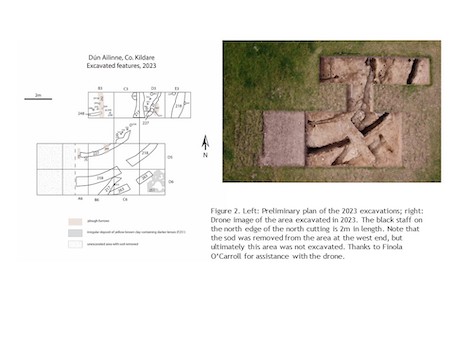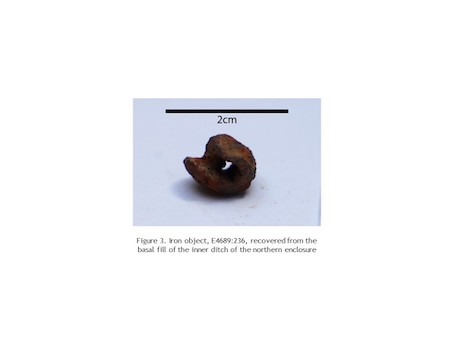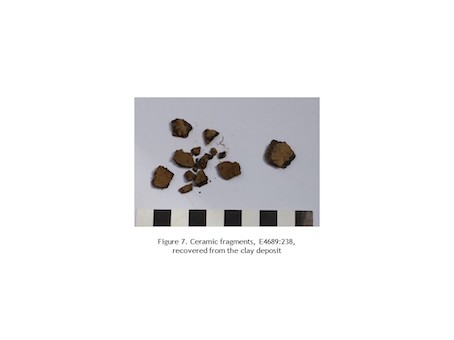County: Kildare Site name: Dún Ailinne
Sites and Monuments Record No.: KD028-038 (including -038001 through -038006) Licence number: E0004689 (C000748)
Author: Susan A. Johnston
Site type: Ceremonial centre
Period/Dating: Multi-period
ITM: E 681962m, N 707912m
Latitude, Longitude (decimal degrees): 53.115462, -6.775661
A four-week field school excavation was carried out at Dún Ailinne, Co. Kildare, from June 19–July 14, 2023, continuing the excavation of two ditched enclosures identified through a magnetometer survey (2006–2008). Both are circular and intersect, the one to the north slightly larger than the one to the south (18m diameter versus 14m diameter respectively). They are located within a large enclosure that rings the summit of the hill (identified through magnetometer survey and explored through excavation in 2016) but are about 50m to the north-northwest of the Iron Age timber structures identified in earlier excavations (1968–1975).
In this season, our primary goals were to 1) understand the chronological relationship between the northern and southern enclosures, 2) get a better understanding of the history and use of both enclosures and 3) trace a clay deposit encountered in 2022. We opened an area between the southern extensions of the 2022 excavation and also extending to the north of this (Figure 1), encountering a maximum of 51 archaeological features. We further excavated the southern enclosure and the inner and outer ditches of the double-ditched northern enclosure; all appear to have been recut a number of times (Figure 2). As seen previously, both ditches of the northern enclosure were cut into bedrock, though the variable depth of the bedrock made for variable depths. Despite this, the outer ditch was shallower than the inner, a feature also noted in 2022. In places the southern enclosure was also cut into bedrock, though this was not consistent across its entire length. While the stratigraphy in places was complex, we were able to determine that the southern enclosure is underneath the northern, predating it.
We also excavated another linear feature, F227, which appears to be a third enclosure. This one was highly irregular across all dimensions; its width ranged from 0.22-0.48m with sides that were generally undulating, and while its maximum depth was 0.27m and in places its base was on the bedrock, elsewhere it shallowed out almost completely. No artefacts were recovered from this feature, but it was underneath the southern enclosure, making it the earliest of the three.
Taken together, there would appear to be sequence of enclosure construction. F227 was the first, followed by the more ambitious southern enclosure, and finally the northern enclosure, which is the most elaborate. Each of the latter two was also recut at least once, and possibly multiple times, indicating continued interest in modifying these structures. Similarly, it is also possible that the northern enclosure was originally a single-ditched feature, with the outer ditch being added later. Whether this sequence reflects continual rebuilding of different versions of the same monument or instead represents three discrete phases of the use of this area (potentially separated by significant periods of time) is uncertain.
In addition to the enclosures we excavated 4–6 plough furrows, another linear feature, a single pit, and a number of stake-holes (15 certain and 2 possible) and post-holes (12 certain and 3 possible). The second linear feature, F248, is somewhat enigmatic, mostly linear but expanding into rounded terminals at both ends. Some of the stake-holes formed patterns; one line ran along the interior edge of F227 and an arc of stake-holes near F248 may be associated with it. Finally, a single pit, F228, cut the southern enclosure ditch on its inner (western) side. We also defined the western edge of the clay deposit encountered in 2022. This was a thin layer of yellow-brown sandy clay 20–40mm thick and containing almost no stone. Unlike the section excavated in 2022, it lacked the dense patches of burned material. It was highly irregular in outline and discontinuous in places, but it clearly overlay the outer ditch of the northern enclosure, making it later than this feature.
As is typical at Dún Ailinne, few artefacts were recovered from the features excavated. Most were lithics, eleven flint and three quartz. Among the flint there were three round scrapers and a probable implement that was snapped across the middle, making its original shape uncertain. The rest of the lithics were unretouched flakes. There was also a fragment of stone (E4689:225) which could have been either a hammerstone or a battered fragment of axehead.
A single metal object, E4689:236, was recovered from the basal fill of the inner ditch of the northern enclosure (Figure 3). It is small (10mm x 12mm x 2mm thick) and corroded but it did respond to a magnet and so is likely made of iron. It is either U-shaped or cylindrical depending on whether the area connecting the two sides is metal or corrosion. If it is U-shaped then it may be a binding strip but if cylindrical then it could be a toggle or some other kind of fastener. While it is corroded, the metal is still clearly visible on much of the piece.
About fifteen very small ceramic fragments were recovered from the clay deposit, the largest being 16mm x 15mm (Figure 4). All are the same colour (medium brown outer and inner surface with a blackened core), suggesting they are from the same vessel. If so, it was very thin walled, being 5mm thick. One sherd is possibly a rim but all are eroded and extremely friable. Five calcined bone fragments were recovered from F248, one of the linear features. The largest was 15mm long, 7mm wide and 6mm thick. They were too small to identify species, but their density suggests a medium to large mammal.
Ten samples from a variety of contexts were collected for radiocarbon dating. Six were from the northern enclosure and its various recuts, and one each came from the southern enclosure, both linear features (F227 and F248) and a stake-hole to the west of F227. All artefacts and samples are now in the National Museum.




14111 Westholme Ct., Bowie, MD, 20715 USA